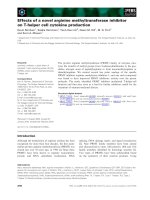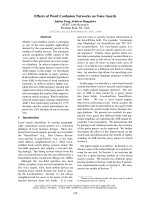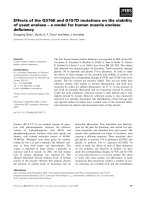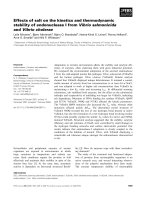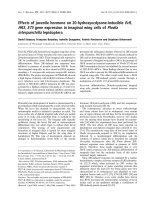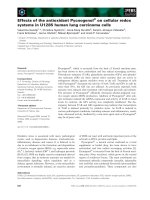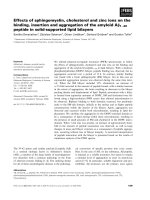Báo cáo khoa học: "Effects of sylvicultural practices on nutrient status in a Pinus radiata plantation: Nutrient export by tree removal and nutrient dynamics in decomposing logging residues" ppt
Bạn đang xem bản rút gọn của tài liệu. Xem và tải ngay bản đầy đủ của tài liệu tại đây (351.83 KB, 12 trang )
Original article
Effects of sylvicultural practices on nutrient status
in a Pinus radiata plantation:
Nutrient export by tree removal and nutrient
dynamics in decomposing logging residues
Guzmán Ouro, Pilar Pérez-Batallón and Agustín Merino
*
Department of Soil Science and Agricultural Chemistry, Escuela Politécnica Superior, Universidad de Santiago de Compostela,
27002 Lugo, Spain
(Received 9 May 2000; accepted 11 September 2000)
Abstract – The effects of logging residue management practices on export and dynamics of nutrients were studied in a plantation of Pi-
nus radiata D. Don growing on an infertile soil, in a humid, temperate area of NW Spain. The export of nutrients due to the removal of
wood and loggingresiduesduring thinning andclear-cutting was evaluated byestimation of nutrient storesin the above-ground biomass
and in the soil. Nutrientdynamics in decomposing slash needles andtwigs were monitored over one year ina thinned stand and in anad-
jacent clear-cut area. Comparison of nutrient release in decaying residues with the nutrient store in tree biomass as well as inputs via lit-
terfall andatmosphere alloweddiscussion of possibleimplications forsustainable sylviculturein these plantations.Nutrient releasefrom
decomposing material increased following clear-cutting and to an even greater extent, after mechanical incorporation of logging resi-
dues to the mineral soil, which substantially increased the short-term flush of some nutrients.
logging residues / decomposition / tree harvesting / thinning / forest nutrient cycling
Résumé – Effetsdes pratiques forestièressur la nutritiond’un peuplement de Pinusradiata : exportation deséléments minéraux
et dynamique desrésidus en décomposition. Les effets de l’utilisationdes résidus d’exploitations forestièressur l’exportation etla dy-
namique des éléments minéraux ont été étudiés dansune plantation de Pinus radiataD. Don située sur unestation non fertile et dansune
région humide et tempérée du Nord-Ouest de l’Espagne. Le flux d’éléments minéraux dû à l’exportation du bois et des résidus de l’ex-
ploitation forestière à la suite d’une éclaircie et d’une coupe rase a été évalué à partir de l’estimation des réserves d’éléments minéraux
dans la biomasse aérienne forestière et dans le sol. La dynamique des éléments minéraux provenant des résidus en décomposition d’ai-
guilles et de brindilles a été suivi pendant un an dans une parcelle éclaircie et aussi dans une zone de déboisement adjacente. La compa-
raison de la libération d’éléments minéraux en décomposition avec la réserve d’éléments minéraux dans la biomasse des arbres, de
même que les apports par les pluviolessivats et les pluies incidentes nous ont permis de discuter des implications possibles pour assurer
la pérennité de la production forestière. La libération des éléments minéraux à partir de matières en décomposition augmente après le
défrichement total, et ceci tout particulièrement après l’incorporation mécanique des résidus d’exploitations forestières au sol minéral,
laquelle augmente de façon appréciable la libération d’éléments minéraux.
résidus d’exploitation forestière / décomposition / récolte / éclaircissement / dynamique des éléments minéraux
Ann. For. Sci. 58 (2001) 411–422
411
© INRA, EDP Sciences, 2001
* Correspondence and reprints
Tel. +34 982 252231; Fax. +34 982 241835; e-mail:
1. INTRODUCTION
In areas of forest plantations designated for timber
production, logging residues are subjected to different
management techniques during thinning, clear-felling
and site preparation. Owing to their high nutrient con-
tents, these components are of considerable importance
to the nutrient economy of forest sites. In clear-cut stands
the residues can be left on site at the surface, removed (in
some cases along with the humus layer), mixed with the
mineral soil or burnt. The repeated removal of the resi-
dues in short-rotation plantations can reduce the ability
of the system torestorethenutrients extracted during for-
est exploitation [14, 17, 35].As a consequence, this prac-
tice is observed to reduce the base saturation in final
felling as well as in first thinnings [25]. When not re-
moved, accumulation of the residues on the ground or
their incorporation into the soil can have a substantial ef-
fect on soil environmental conditions, such as soil mois-
ture and temperature. This can significantly alter
microbial activity, which influences the rateofdecompo-
sition of organic matter and the nutrient turnover [8, 13,
16]. These, in turn, have an important influence on soil
nutrient status as well as on the growth and survival of
seedlings [21].
In Northern Spain, Pinus radiata is grown on rota-
tions ranging between 25 and 35 years, depending on site
characteristics and environmental factors [33]. As these
plantations are not fertilized, forest growth largely de-
pends on the cycling of nutrient elements. Thinning is a
common practice (tree density is reduced from
1 500–2 000 trees ha
–1
to 600–800 trees ha
–1
during the
first operation and to 300–500 trees ha
–1
during subse-
quent felling) and which logging residues are deposited
on the forest floor. After clear-felling, highly mecha-
nized operations, including deep soil ploughing and/or
removal of logging residues, are often employed to pre-
pare the site for planting. Previous studies have shown
that such intensive management practices have a signifi-
cant effect on soil conservation [10] and lead to a reduc-
tion in soil fertility [20], which has consequences for the
nutrient status and production of the following rotation
[19]. It is thought that these changes may be partially
caused by theremovalof nutrient-rich residues and byin-
creased decomposition following clear-felling. Other
studies [9] point out that the relatively low release of Ca
and Mg by weathering and the strong mineral uptake of
fast growing standscanlead to negative nutrientbudgets.
The aim of the present study was to investigate the in-
fluence of logging residue management during thinning,
clear-felling and site preparation operations on soil
nutrient status. The possible consequences of tree bio-
mass removal on nutrient export were assessed by esti-
mation of nutrient stores in the above-ground biomass
and in the soil. The influence of logging residue manage-
ment on decomposition rates and nutrient dynamics in
decaying logging residues was monitored for one year in
a thinned stand and in an adjacent clear-cut area. In the
latter, the effect of intensive site preparation involving
logging residue incorporation to the mineral soil was
compared with the conventional practice of leaving it on
the forest floor. In all plots, the release or accumulation
of nutrients in decomposing material was compared with
storage in the ecosystem and atmospheric inputs.
2. MATERIALS AND METHODS
2.1. Site description
The study was carried out on a mature (25 year-old)
Pinus radiata D. Don. plantation located 10 km east of
Lugo (NW Spain) at an altitude of about 500 m. The cli-
mate of the area can be classified as Temperate Subtropic
with Humic Winter. The average annual precipitation is
1 022 mm and temperature, 11.7
o
C. The topography of
the study site is relatively flat. The soil, a Humic
Cambisol [11] developed on granodiorite, has a sandy
loam texture (15–17% clay content), high bulk density
(1.4 g cm
–3
), moderate organic matter content in the up-
per mineral horizon (3.0%) and is strongly acidic (pH in
KCl 3.3).
2.2. Experimental design
In November 1996 part of the plantation was thinned
to reduce the tree density from 500 to 350 trees ha
–1
,
while the remainder of the plantation was clear-cut. A
plot was established in the thinned plantation, while in
the clear-cut area, two different management tech-
niques were used for site preparation. In one area, the
residues and litter were mechanically mixed into the up-
per 20 cm of the mineral soil, whereas in the other area
the residues were left on site without any soil distur-
bance. The study was carried out over the 12 months fol-
lowing harvesting and site preparation. Biomass and
nutrient stores were determined in above-ground tree
components, litter and soil, and nutrient input by litterfall
and canopy drip was recorded at regular intervals during
412 G. Ouro et al.
1997. Soil temperature, moisture and slash decomposi-
tion were measured in the thinned and clear-cut areas
throughout the period of the study.
2.3. Nutrient store and cycling in the stand
For estimation of biomass, the breast height diameter
(dbh) of all trees wasmeasured and, during thinning, five
trees of different dbh were selected for weighing and
sampling of the different components. Estimates of
above-ground biomass of the stand before and after thin-
ning were carried out on the basis of previous equations
established for Pinus radiata in different plantations in
the region [7]. The above ground biomass, comprising
the following components: branches (more than 1 cm),
twigs (less than 1 cm), needles, stem bark and stem
wood, was measured separately.
Litterfall in the thinned stand was collected monthly
in each of six litter traps (0.25 m
2
) located at random in
the plot, andanalysed.Six rain gauges weresetat random
in the plot and in the nearby open area to collect
throughfall and bulk deposition, respectively. Six trees
were chosen to collect stemflow (using polyethylene col-
lars). Organic horizons were sampled using 30 cm diam-
eter rings at six sites in theplot. For mineral soil samples,
3 pits were dug and samples collected from each horizon
for physical and chemical analysis.
2.4. Decomposition rates and nutrient dynamics in
decomposing logging residues.
The temperature of the soil was measured (at a depth
of 10 cm) every hour, from the beginning of February on-
wards, with a thermistor connected to a data logger. Soil
moisture content was determined gravimetrically (at
0–12 cm).
Rates of decomposition of slash needles and twigs
were estimated in the thinned and harvested plots using
the litterbag technique. Needles and twigs (maximum
diameter 1 cm) werecollectedfrom logging residues dur-
ing harvesting and were thoroughly mixed. Decomposi-
tion was determinedasthe loss of weightofthe incubated
material. The equivalent of 6 g oven-dry weight (65
o
C)
of fresh needles or twigs were placed in nylon bags (15 ×
15 cm) with a mesh size of 0.5 mm. This size of opening
was used to avoid physical loss and provide soil organ-
isms with access to the litter, although it excluded larger
arthropods and earthworms [8]. Forty litterbags were
mixed with ground cover of logging residues (thinned
stand and unprepared clear-cut area) or buried at a depth
of 15 cm (prepared clear-cut area). Incubations were
started in December, 1996 and were carried out until De-
cember, 1997. Every sampling, 8 litterbags (4 with nee-
dles and 4 with twigs) were chosen at random from each
plot, and carefully transported to the laboratory avoiding
loss of material. The samples were oven dried at 65
o
Cto
constant weight and weighed accurately.
The annual decay constant (k) was calculated follow-
ing the negative exponential decay model [24]:
k=ln (X/X
o
)/t,
where X
o
is the initial dry weight, X is the dry weight re-
maining at the end of the investigation and t is the time
interval.
2.5. Vegetation and soil analyses
The oven-dried (60
o
C) samples of the vegetal mate-
rial were milled (0.25 mm) and digested with H
2
SO
4
/
H
2
O
2
[26]. Soil samples collected in cores for bulk den-
sity were oven-dried to constant weight at 105 ºC. Soil
samples for chemical analysis were air-dried and sieved
with a 2-mm screen before analysis. Soil available P was
extracted using the Mehlich IIIprocedure.Soil exchange-
able cations (K
+
,Ca
2+
and Mg
2+
) were extracted with
unbuffered 1 N NH
4
Cl. Determinations of, K, Ca, Mg in
the vegetal digested samples and in soil extracts were
made by atomic absorption spectrophotometry, whereas P
was determined photometrically by the molybdenum-
blue-method. Carbon, N and S in needles were analyzed
in milled materialbycombustion, using a Lecoanalyzer.
Total element storage in the soil was calculated from
the depth of each horizon, bulk density and mean result
for the analysis and the adjusted for gravel content.
2.6. Data analysis
T-tests were used to test for significance of differ-
ences among the four plots and between the two materi-
als, needles and twigs, at specified sampling times.
Differences were considered significant at p < 0.05, for
all parameters.
Effects of sylvicultural practices on nutrient status in Pinus radiata 413
3. RESULTS AND DISCUSSION
3.1. Nutrient store and export rates by harvesting
and thinning
Table I shows the element concentrations in above-
ground tree components. The highest concentrations of
elements in the living organs were found in needles and
fruits, and the lowest in stem wood. There was a general
trend of decreasing concentrations of nutrient elements
in the order, needles, fruits, twigs, branches, stem bark
and stem wood. The concentration of P in needles was
below the critical levelsatwhichgrowth is potentially re-
duced, whereas that of Mg was close to the limit [38].
This coincides with other studies in the region [19, 30,
33], which showed that the growth of these plantations is
mainly limited by availability of these elements. In com-
parison with needles and twigs, the organic horizon had
lower concentrations of almost all elements, especially N
and K, but had a higher concentration of Ca. These lower
concentrations were probably due to retranslocation be-
fore abscission of needles, (as shown by the composition
of abcised needles, table I) and to losses during decom-
position.
The above-ground biomass of the stand and the con-
tents of nutrientsinthe tree biomass areshownin table II.
Biomass accumulation in the stand was 252,4 tons ha
–1
,
and the proportions of needles, fruits, twigs, branches,
stem bark and stem woodwere 3.9, 2.6, 0.6, 18.3, 3.1 and
414 G. Ouro et al.
Table I. Concentrations of nutrient elements (mg g
–1
) in above-ground tree components and soil humus layer.
Components Nutrient elements
N P S K Ca Mg
Needles 16.1 0.9 1.4 7.8 2.7 0.9
Abcised needles* 8.4 0.4 0.8 4.2 2.7 0.4
Fruits 8.4 0.7 0.7 4.8 2.1 0.4
Twigs 6.4 0.4 0.6 5.6 2.5 0.8
Branches 2.3 0.2 0.4 4.4 1.4 0.7
Stem bark 1.8 0.2 0.13 0.9 1.9 0.3
Stem wood 0.9 0.07 0.17 1.9 1.1 0.3
Humus layer 9.9 0.7 0.9 1.2 3.9 0.7
* Average values from samples collected monthly throughout the 12 months.
Table II. Mass and contents of nutrient elements in the above-ground tree biomass before thinning.
Components Nutrient elements (kg ha
–1
)
Mass (tons ha
–1
)N S P K Ca Mg
Needles 9.9 159.8 14.4 9.0 77.4 26.3 9.1
Fruits 1.4 11.4 1.2 0.9 6.5 2.8 0.5
Twigs 6.4 41.3 3.8 2.3 36.3 15.8 5.0
Branches 46.1 105.1 17.5 10.1 203.4 65.0 31.4
Stem bark 7.8 14.0 1.0 1.2 7.2 14.6 2.4
Stem wood 180.7 160.9 30.9 12.1 345.2 207.9 59.6
Logging residues
(1)
63.9 317.6 36.9 22.4 323.6 110.0 46.0
Total biomass 252.4 492.5 68.8 35.8 676.0 332.5 108.1
Organic Hor. 29.2 289.4 25.9 21.6 35.6 112.6 19.3
Mineral Hor. (0–20 cm)
(2)
– 1701.5 215.3 17.5 3252.5 390.5 502.4
(1)
Includes needles, fruits, twigs and branches.
(2)
N an S are total amounts. P, K Ca and Mg are available amounts.
71.6%, respectively. Stem wood contained the greatest
proportion of elements (48%) within the stand. Total nu-
trient element accumulation in the organs decreased in
the following order: stem wood, branches, needles,
twigs, stem bark and fruits. Levels of nutrient elements
decreased in the following order: K, N, Ca, Mg, S and P.
Needles, twigs and branches, although representing only
25% of the biomass of the stand, accumulated the largest
proportion of N, P and S contained in above-ground tree
biomass. Stem wood plus bark contained the largest pro-
portions of Ca, Mg and K contained in the biomass. This
pattern is similar to that reported by Schlatter et al. [34]
for some radiata pine plantations in Chile. The amounts
of nutrients contained in the organic horizon were con-
siderably lower than those reported by Barraqueta and
Basagoiti [4] foranotherPinus radiata plantation located
on a more fertile soil.
The P content of the total biomass was slightly lower
than the amount contained in the organic horizon plus the
extractable P in the mineral soil (0–20 cm depth). The to-
tal contents of N and S in the mineral soil were much
higher than the amounts in the total biomass. The
amounts of extractable K, Ca and Mg in the mineral soil
were also substantially higher than those in the total bio-
mass.
Annual nutrient accumulation and uptake were calcu-
lated for the thinned stand (table III). The increase in an-
nual biomass was 7.07 mg ha yr
–1
, and the annual
accumulation of nutrient elements was 50 kg ha
–1
yr
–1
,
which is within the range reported for other coniferous
forest systems [8, 28].
The input of nutrient elements via litterfall was
40.9 kg ha
–1
yr
–1
. Litterfall composition was dominated
by N (50%), K (26%) and Ca (14%) (table III). The
amount of needle litterfall corresponds with the pattern
reported by [37] for radiata pine plantations of different
ages, although lower than the data reported by
Barraqueta and Basagoiti [4] for another Pinus radiata
plantation in a less limited site in Northern Spain.
The most abundant elements in bulk deposition and
throughfall were N and K. With the exception of N
and Mg, the concentrations of all elements were higher in
the throughfall than in bulk deposition, the largest differ-
ences being for K and Ca. This data reflects the impor-
tance of dry deposition and the leaching of ions from the
canopy. The amount of nutrients leached from the can-
opy and boles was estimated as the total amount of nutri-
ents in throughfall and stemflow minus the amount of
nutrients in bulk deposition (table III).
The annual uptake (table III) of nutrients by the stand
was estimated as the sum of the annual retention of nutri-
ents, the amount returned to the soil in litterfall and the
amount leached from the canopy and boles [37]. The nu-
trients returned by litterfall and leaching made up around
60% of the N, P, K and Ca assimilated annually in the
stand. Similar figures have been reported by Pastor and
Bockeim [27].
3.2. Decomposition rates of logging residues and
nutrient release
3.2.1. Soil environment
Soil temperature increased substantially following
clear-cutting. Thus, the mean daily temperatures in the
Effects of sylvicultural practices on nutrient status in Pinus radiata 415
Table III.Annual accumulation,return, leachingand uptakeof theradiata pinestand. For leaching,values inbrackets aregiven inL m
–2
.
Nutrient elements (kg ha
–1
year
–1
)
Mass (tons ha
–1
year
–1
) N P K Ca Mg
Annual accumulation 7.1 13.8 1.00 18.9 9.3 3.00
Return by litterfall* 2.4 20.6 1.03 10.7 5.6 1.03
Leaching
Throughfall (882.9) 6.9 0.49 21.4 9.6 3.15
Stemflow (5.2) 0.7 0.02 0.3 0.02 0.01
Bulk deposition (1 054.1) 8.1 0.19 4.2 1.9 5.56
Total leaching –0.4 0.32 17.5 7.7 –2.4
Uptake by trees 34.4 2.35 47.2 22.6 4.03
* Needles, branches and fruits.
unprepared and prepared sites, were 1.7 and 2.3
o
C
higher, respectively, than in the thinned stand (table IV).
The diurnal amplitudeofsoil temperatures also increased
after clear-cutting, especially in the unprepared plot. The
increases in soil temperature recorded after harvesting
were probably due to the greater incidence of solar radia-
tion following removal of tree cover. In the untreated
plot, the slash remaining on the surface may have acted
as a mulch keeping the soil warmer during the night.
Clear-cut plots also had higher soil moisture contents
than the thinned stand, and much more than the unpre-
pared plot (table IV). The highersoilmoisturecontents in
harvested plots were probably due to the greater input of
water as a consequence of the tree cover removal; the
vegetation cover in the uncut stand intercepted rainfall,
decreasing by up to 27% the amount of water reaching
the soil (during the study period bulk deposition was
1 054 mm and canopy drip plus stemflow, 888 mm).
Moreover, the incorporation of logging residues into the
soil probably enhanced water retention, whereas in the
plot where they were deposited on site, evaporation may
have been reducedbythe layer of residueson the surface.
3.2.2. Weight loss of decomposing residues
Changes in weight loss of needles and twigs are
shown in figure 1. The decomposition rate in the unpre-
pared plot did not differ significantly from that of the
thinned stand, which mayhavebeendue to desiccation of
the superficial layer of logging residues. Clear-cutting
and site preparation techniques led to higher decomposi-
tion rates of slash needles and twigs, than in the thinned
stand. The greatest weight losses were observed in the
plots where logging residues were incorporated into the
416 G. Ouro et al.
Table IV. Comparison of mean daily temperature (T), mean
daily minimum temperature (T
m
) and mean daily maximum tem-
perature (T
M
) and soil moisture content (at a depth of 10 cm) in
thinned plantation and harvested plots where different logging
residue management techniques were used.
Plot T
(1)
(ºC)
T
m
(1)
(ºC)
T
M
(1)
(ºC)
T
M
–T
m
(1)
(ºC)
Moisture
(%)
Thinned stand 13.1 12.7 13.6 0.9 15.4
Residues incorporated 14.8 13.7 15.7 2.0 23.8
Residues left on site 15.4 14.4 15.8 1.4 28.1
(1)
Measurements made between February and December 1997.
Figure 1. Remaining slash needles (a) and
twigs (b) after decomposition in the
thinned stand and in the prepared and un-
prepared plots after clear-felling. Each
value is the mean of four samples.
mineral horizon. By the end of the 12-month period, the
needles in these plots had lost 70% of their initial dry
weight. In the thinned plot and in the plot with logging
residues on the ground the mass losses were 36 and 38%
respectively. The needle decomposition rate constants
(k) in the thinned stand and in the prepared and unpre-
pared harvested plots were estimated to be –0.45, –1.2
and –0.51, respectively. Twigs decomposed more slowly
than needles in all plots studied. The greatest losses oc-
curred in the plot where logging residues were incorpo-
rated (50%), whereas weight losses were similar (20%)
in the other plots.
The decomposition constants recorded in the stand is
typical of temperate forests [6]. The decomposition rates
of slash needles (greater than 30% for the 12 month-pe-
riod) were high in comparison with those observed by
others authors for the same species in other temperate ar-
eas [3, 8]. The annual decay constant (k) of 1.2 yr
–1
in the
plot where logging residues were incorporated is compa-
rable to those reported for buried fine roots in a subtropi-
cal humid forest [1]. The increased decomposition
following mechanical incorporation of logging residues
was also observed by Lundmark-Thelin and Johansson
[16]. This effect is possibly due to the higher microbial
activity resulting from the incorporation of fresh and eas-
ily decomposable organic matter [32], and thehigher soil
temperature and humidity in the soil. Measurements of
microbial biomass made in the plots confirm this [29].
3.2.3. Nutrient dynamics in decomposing residues
The changes in absolute levels of different elements
are shown in figure 2. The nutrient contents of decom-
posing needles and twigs incubated throughout
12 months (expressed as a percentage of the initial nutri-
ent content) were calculated for each element from the
nutrient concentration and the amount of dry weight loss
(table V).
In all plots the concentrations of some elements (K, P
and S) in incubated needles decreased consistently
throughout the study period. Some of the nutrients (Ca
and Mg), however, accumulated in the needles beforethe
release began. In contrast, in twigs no elements were lost
from the beginning of the incubation period.
There was an initial accumulation of N in slash nee-
dles during the three first months in all plots (figure 2a).
In the thinned stand, there was subsequent accumulation
of N, resulting in net accumulation of this element by the
end of the study period. In the harvested plots, on the
other hand, there was a clear net release of N. By the end
of the incubation period, the greatest release had taken
place in the prepared plot, where 42% of the initial
amount of N in needles was lost (table V). The N dynam-
ics of twigs followed a very different trend to that of nee-
dles. The level of N did not change during the first
10 months of incubation and thereafter it was retained in
all plots, especially in the uncut stand.
Accumulation of N in the initial stage of decomposi-
tion, followed by net release has also been described for
leaves by other authors [5, 22]. The accumulation of N is
due to microbial immobilization and simultaneous deg-
radation of easily decomposable substances, such as car-
bohydrates, along with additions by atmospheric N
deposition during decomposition. The initial C/N ratios
of slash needles and twigs were 33 and 75, respectively –
values that are high enough to favour N immobilization.
The higher immobilization of N in twigs may reflect the
higher C/N ratio of this material. This behaviour
Effects of sylvicultural practices on nutrient status in Pinus radiata 417
Table V. Nutrient contents at the end of the study period expressed as the percentage of the initial content. Positive values indicate net
accumulation and negative values, net loss.
Plots Weight C N S P K Ca Mg Mn
NEEDLES
Thinned –36.2 –35 +24 –47 –63 –84 –23 –70 +27
Prepared –70.0 –64 –42 –71 –77 –87 –66 –83 –48
Unprepared –38.5 –23 –20 –63 –51 –47 –35 –64 +35
TWIGS
Thinned –19.8 –29 +161 +30 –12 –11 –53 –31 +4
Prepared –50.0 –44 +96 +53 –28 –74 –58 –55 –55
Unprepared –19.2 –17 +66 +20 –10 –78 –39 –34 +10
indicates that initial levels of N in decomposing mate-
rial were below the requirements of decomposing
organisms. Release of N from decomposing material
takes place when this element reaches a certain critical
level, high enough so that microbial activity is not lim-
ited [5].
418 G. Ouro et al.
Figure 2 (continued on next page). Changes in absolute amount of elements with time for radiata pine slash needles and twigs incu-
bated in the thinned stand and in the prepared and unprepared plots after clear-felling.
Analysis revealed large differences in the P dynamics
of decomposing needles and twigs. In the slash needles,
although there was an initial rapid release of this element
in all plots, the most rapid loss of P was observed in the
prepared plot. Thus, the total losses of P from needles
throughout the study period ranged from 51% in the un-
prepared harvested plot to 77% in the prepared plot (ta-
ble V, figure 2b). Other studies have described similar
patterns of P loss in incubated leaves of Pinus radiata [3,
8] and other species [16, 31]. In incubated twigs, P was
accumulated during the first9 months and levels then de-
creased rapidly. The losses of P in twigs made up be-
tween 10–12% in the uncut and unprepared plots and
28% in the prepared plot.
Sulphur was also released from the incubated needles
in all plots (figure 2c). The levels of this element de-
creased sharply in the first months and thereafter de-
creased more gradually. At the end of the study period
the lowest S losses were observed in the uncut plot,
whereas no differences were found between the har-
vested plots. Other authors have also observed initial
losses of S in incubated needles [6, 8]. In twigs, S con-
tents were fairly constant in all plots during the first
9 months and then increased substantially.
The amounts of K in needles decreased rapidly from
the beginning of the incubation until the end of the study
period in all plots (figure 2d). The net losses of K in the
incubated needles in the uncut and prepared plots were
Effects of sylvicultural practices on nutrient status in Pinus radiata 419
Figure 2 (continued). Changes in absolute amount of elements with time for radiata pine slash needles and twigs incubated in the
thinned stand and in the prepared and unprepared plots after clear-felling.
around 85%, whereas in the unprepared plot 47% of K
was lost. The K content of twigs also decreased through-
out the study period, although the losses were not contin-
uous. High losses of K have been reported for other
species [15, 31]. The high mobility of K is attributed to
the fact that this element it is not a constituent of cell
structures, and that its movement is mainly due to physi-
cal leaching [2].
After a short period in which Ca contents remained
fairly constant, there was slow release of this element
from needles and twigs throughout the rest of the incuba-
tion period (figure 2e). The greatest losses of Cawereob-
served in the prepared plot, where levels in needles and
twigs decreased by 66 and 58%, respectively. The mg
contents of needles and twigs did not change substan-
tially during the first 9 months of incubation, but after
this period, the levels decreased considerably (figure 2f).
In both needles and in twigs, Ca and mg were relatively
immobile during the initial stages of decomposition, as
has been reported in other studies [15]. According to
McClaugherty and Berg [18] these elements are confined
to the structural compounds of plant tissues and are re-
leased during the decomposition of structural com-
pounds. No large differences were detected in the total
amounts of Mnreleasedin the different plots(figure 2g).
The data of this study suggests the order ofmobilityof
elements to beK>Mg>P>S>Ca,Mn,N,which gener-
ally corresponds to thatpreviously reported for other for-
est systems and tree species [15, 31]. This pattern is
partially due to the physical and biological degradation
of cell walls and membranes required before the release
of certain elements.
The higher rates of decomposition and nutrient re-
lease of needles compared with twigs are most likely to
be due to the different initial nutrient concentrations
[36]. Since needles were initially richer in all elements,
microoganisms were not limited to the same extent as in
twigs, implying that there is a more rapid release of ele-
ments from these components. Thus, the increases in N,
P, K and mg observed in incubated twigs during the first
months of incubation suggest that these elements were
limiting to microbial growth and were consequently im-
mobilized by microorganisms. The increased decompo-
sition rate in needles may also be due to the greater
concentration of labilecomponents,such as proteins, sol-
uble carbohydrates and phenolic compounds [23].
3.3. Possible implications of tree harvesting and
logging residue management on nutrient status of
forest plantations
Nutrient loss due to export of tree biomass in shown in
table VI. The results of this study show that above-
ground biomass includes a significant proportion of the
nutrients accumulated in the system. Logging residues
contain most of the N, S and P accumulated in the tree
biomass, whereas stemwood and bark accumulate the
highest amounts of K, Ca and Mg.Whole-tree harvesting
leads to large losses of some elements, especially P and
Ca and to a lesser extent, N andS.In the case of P, the ex-
port is much higher than the available amount of this ele-
ment in the upper mineral soil layer (table II). This may
partially explain the lower levels of P, N and S found in
the soils and foliage in some plantations in the region
where logging residues are removed after clear-cutting
[19, 20]. Substantially lower losses were produced dur-
ing thinning or stem-only harvesting.
The total amounts of nutrients mobilised during de-
composition of the logging residues (table VII) can also
be compared with the annual nutrient accumulation in
tree biomass and the annual uptake by tree vegetation,
which were calculated for the thinned stand (table III).
420 G. Ouro et al.
Table VI. Export of nutrients due to different harvesting meth-
ods (in kg ha
–1
). In parenthesis the percentages with respect the
storage in the upper 20 cm of soil mineral layer (table II) are
shown.
NSPKCaMg
Thinning 52.6
(3.1)
9.6
(4.4)
3.9
(22.6)
105.7
(3.2)
66.5
(17.0)
18.6
(3.7)
Stem-only
harvesting
174.9
(10.3)
31.9
(14.8)
13.4
(76.6)
352.4
(10.8)
222.5
(57.0)
62.0
(12.3)
Whole-tree
harvesting
492.5
(28.9)
68.8
(31.9)
35.8
(204.6)
676.0
(20.7)
332.5
(85.1)
108.1
(21.5)
Table VII. Total amounts of nutrients released (kg ha
–1
) from
decomposition of slash needles and twigs over the 12 month
study period. For the calculation, biomass of needles and twigs
generated in thinning
(1)
(3 tons of needles ha
–1
, 1.9 tons of twigs
ha
–1
) orclear-cutting
(2)
(9.9 tonsof needles ha
–1
, 6.4tons of twigs
ha
–1
) were used.
NPSKCaMg
Thinned
stand
(1)
–18.0 1.4 2.6 25.5 4.7 2.6
Prepared
(2)
14.2 5.4 8.0 72.0 36.0 9.8
Unprepared
(2)
0.0 3.3 9.7 43.6 21.7 7.3
In the thinned stand the amounts of Ca, K and P re-
leased throughout the year by decomposing slash were
higher than theinputs of this elements by throughfall and
stemflow (table III). In this stand the release of Ca by de-
composing material was higher than the amounts accu-
mulated annually in the newly formed biomass, whereas
the amounts of P, K and Mg released were similar to
these accumulated in biomass. These results demonstrate
the important contribution of the decomposing slash to
the nutrient status of the plantation. Retention of N in
green needles under thinned stands has also been found
by Baker et al. [3], who suggested that this effect may
cause lower N availability in N-poor sites. The possible
effect of the removal of logging residues generated by
thinning was considered in a recent study by Olsson [25],
who found no measurable changes in soil nutrient pools
in thinned standswherelogging residues were removed.
The greater input of residues and the faster decompo-
sition rates meant that harvested plots showed a greater
net release of all elements than the thinned stand, espe-
cially for N, P and K. In both harvested plots the amounts
of nutrients released from decomposing slash over the
study period were higher than the annual nutrient accu-
mulation in the tree biomass. Previous studies have also
evaluated the nutrient dynamics of decomposing mate-
rial following forest harvesting. Our data agrees with the
study of Lundmark-Thelin and Johansson [16], who also
found higher decomposition rates andnutrient release af-
ter incorporation of logging residues.
4. CONCLUSIONS
The results show that site preparation involvingincor-
poration of residues to the mineral soil may lead to a loss
of nutrients from the system. This however, will depend
on the uptake by understorey vegetation and on nutrient
immobilization processes by soil microorganisms. Thus,
the rapid development of grasses and shrubs observed in
these plantations may reduce the nutrient losses. More-
over, in the case of N, determinations of in situ mineral-
ization in the same plots showed that immobilization by
microorganisms played an important role in maintaining
levels of this element in the soil [29]. Phosphorus can
also be immobilised in this way, although the acidic con-
ditions of the soils of this region will also reduce its mo-
bility by fixation in insoluble compounds [12].
REFERENCES
[1] Arunachalam A., Pandey H.N., Tripathim R.S., Maitha-
ni K., Fine root decomposition and nutrient mineralization pat-
terns in a subtropical humid forest following tree cutting, For.
Ecol. Manage. 86 (1996) 141–150.
[2] Baker T.G., Attiwill P.M., Loss of organic matter and
chemical elements from decomposing litter of Eucalyptus obli-
qua L’Herit. and Pinus radiata D. Don., Aust. J. For. Res. 15
(1985) 125–146.
[3] Baker T.G., Will G.M., Oliver G.R., Nutrient release
from silviculturalslash: leaching anddecomposition of Pinusra-
diata needles, For. Ecol. Manage. 27 (1989) 53–60.
[4] Barraqueta P.,Basagoiti M., Acumulaciónde hojarasca y
de los nutrientes en repoblaciones de Pinus radiata en el País
Vasco. Congreso Forestal Español-Lourizán 1993. Ponencias y
Comunicaciones, I, 1993, pp. 295–300.
[5] Berg B., Staaf H., Leaching, accumulation and release of
nitrogen in decomposing forest litter, Ecol. Bull. 33 (1981)
163–178.
[6] Blair J. Nitrogen, sulfur and phosphorus dynamics in de-
composing decidous leaf litter in the Southern Appalachians,
Soil Biol. Biochem. 20 (1988) 693–701.
[7] Brañas J.,Producción de biomasay contenidode nutrien-
tes en plantacionesde Eucalyptus globulus Labill.y Pinus radia-
ta D Don en Galicia. Tesis doctoral, 2000 (en realización).
[8] Cortina J., Vallejo V.R., Effects of clearfelling on forest
floor accumulation and litter decomposition in a radiata pine
plantation, For. Ecol. Manage. 70 (1994) 299–310.
[9] Dambrine E., Vega J.A., Taboada T., Rodríguez L.,
Fernández C., Macías F., Gras J.M., Bilans d´éléments minéraux
dans de petits bassins versants forestiers de Galice (NW
Espagne), Ann. For. Sci. 57 (2000) 23–38.
[10] Edeso J.M., Merino A., González M.J., Marauri P., Soil
erosion under different harvesting managements in steep fores-
tlands from Northern Spain, Land Degrad. Develop. 10 (1999)
79–88.
[11] F.A.O-Unesco, Mapa Mundial de Suelos. FAO, Roma,
1990.
[12] García-Rodeja I., Gil Sotres F., Prediction of parame-
ters describingphosphorus-desorption kinetics insoils of Galicia
(Northern Spain), J. Environ. Qual. 26 (1997) 1363–1369.
[13] Hendrickson O.Q., Chatarpaul L., Robinson J.B.,
Effects of two methods of timber harvesting on microbial pro-
cesses in forest soils, Soil Sci. Soc. Am. J. 49 (1985) 739–746.
[14] Hopmans P., Stewart H.T.L., Flinn D.W., Impacts of
harvesting on nutrients in a eucalypt ecosystem in Southeastern
Australia, For. Ecol. Manage. 59 (1993) 29–51.
[15] Laskowki R., Niklinska M., Matyanski M., The dyna-
mics of chemical elements in forest litter, Ecology 76 (1995)
1393–1406.
[16] Lundmark-Thelin A.,Johansson M.B., Influenceof me-
chanical site preparation on decomposition and nutrient dyna-
Effects of sylvicultural practices on nutrient status in Pinus radiata 421
mics of Norway spruce Picea abies (L.) Kart.) needle litter and
slash needles, For. Ecol. Manage. 96 (1997) 101–110.
[17] Madeira M.A.V.,Changes insoil propertiesunder euca-
lyptus plantations in Portugal, in: Pereira J.S., Landsberg J.J.
(Eds.), Biomass production by fast-growing tress, Kluwer Aca-
demic Publishers, Amsterdam, 1989, pp. 81–99.
[18] McClaugherty C., Berg B., Cellulose, lignin and nitro-
gen concentrations as rate regulating factors in late stages of fo-
rest litter decomposition, Pedobiologia 30 (1987) 101–112.
[19] Merino A., Edeso J.M., Soil fertility rehabilitation in
young Pinus radiata D.Don plantations from Northern Spain af-
ter intensive site preparation, For. Ecol. Manage. 116 (1999)
83–91.
[20] Merino A., Edeso J.M., González M.J., Marauri P., Soil
properties in a hilly area following different harvesting manage-
ment practices, For. Ecol. Manage. 103 (1998) 235–246.
[21] Munson A.D.,Margolis H.A.and BrandD.G., Intensive
silvicultural treatment: impacts on soil fertility and planted coni-
fer response, Soil Sci. Soc. Am. J. 57 (1993) 246–255.
[22] O’Connell A.M., Decomposition and nutrient content
of litterin a fertilizedeucalypt forest,Biol. Fertil. Soils 17 (1994)
159–166.
[23] O’Connell A.M., Decomposition of slash residues in
thinned regrowth eucalypt forest in Western Australia, J. Appl.
Ecol. 34 (1997) 111–122.
[24] Olson J.S.,Energy storageand balance of producers and
decomposers inecological systems,Ecology 44(1963) 322–331.
[25] Olsson B.A., Effects of biomass removal in thinnings
and compensatory fertilization on exchangeable basecations po-
ols in acid forest soils, For. Ecol. Manage. 122 (1999) 29–39.
[26] Parkinson A., Allen S.E., A wet oxidation procedure
suitable for determination of nitrogen and mineral nutrients in
biological materials,Comm. SoilSci. PlantAnal. 6(1975) 1–11.
[27] Pastor J., Bockheim J.G., Distribution and cycling of
nutrients in an aspen-mixed-harwood-spodosol ecosystem in
northern Wisconsin, Ecology 65 (1984) 339–353.
[28] Pearson J.A., Knight D.H., Fahey T.J., Biomass andnu-
trient accumulation during stand development in Wyoming lod-
gepole pine forests, Ecology 68 (1987) 1966–1973.
[29] Pérez-Batallón P., Ouro G., Macías F., Merino A., De-
composition and mineralization of organic matter in a forest
plantation soil following different harvesting management tech-
niques, Ann. For. Sci. (submitted).
[30] Romanyà J., Vallejo V.R., Nutritional status and defi-
ciency diagnosis of Pinus radiata plantations in Spain, For. Sci.
42 (1996) 1–6.
[31] Rutigliano F.A., Alfani A., Bellini L., Virzo De Santo
A., Nutrient dynamics in decaying leaves of Fagus sylvatica L.
and needles of Abies alba Mill, Biol. Fertil. Soils 27 (1998)
119–126.
[32] Salonius P.O., Effects of organic-mineral soil mixtures
and increasing temperature on the respiration of coniferous raw
humus material, Can. J. For. Res. 13 (1983) 102–107.
[33] Sánchez F.,Álvarez J.G., RodríguezR., Rojo A.,Resul-
tados preliminares del estudio de curvas de calidad de estación y
de los factores ecológicos implicados en la productividad de Pi-
nus radiata D. Don en Galicia (España), in: 1 Congreso IUFRO
sobre Silvicultura en America Latina, Valdivia Chile, 1998.
[34] Schlatter J.E., Gerbing V., Oñate M.I., Características y
variabilidad de sitios con plantaciones adultas de Pinus radiata
D. Donen suelosgraníticos delas Regiones VIIIy IX,Bosque 19
(1998) 37–59.
[35] Spangenberg A., Grimm U., Sepeda da Silva J. R.,
Fölster H., Nutrient store and export rates of Eucalyptus uro-
grandis plantations in eastern Amazonia (Jari), For. Ecol. Ma-
nage. 80 (1996) 225–234.
[36] Stevenson F.J., Cycles of soil, carbon, nitrogen, phos-
phorus, sulfur, micronutrients, Wiley, New York, 1986, 380 p.
[37] Turner J., Lambert M.J., Nutrient cycling within a 27-
year-old Eucalyptusgrandis plantationin NewSouth Wales,For.
Ecol. Manage. 6 (1983) 155–168.
[38] Will G.M., Nutrient deficiencies and fertilizer use in
New Zealand exotic forests, Forestry Res. Inst. Bull. (Rotorua,
New Zealand) 97 (1985) 1–53.
To access this journal online:
www.edpsciences.org
422 G. Ouro et al.

